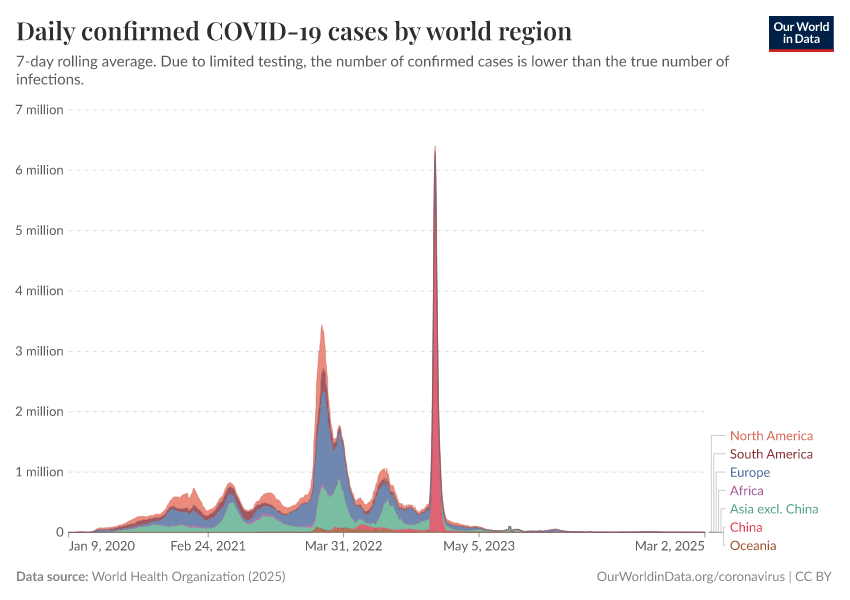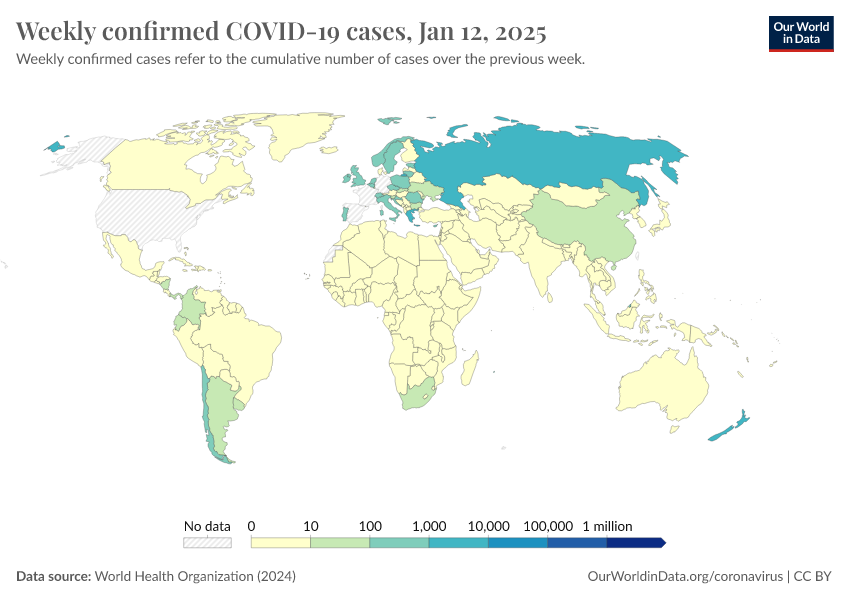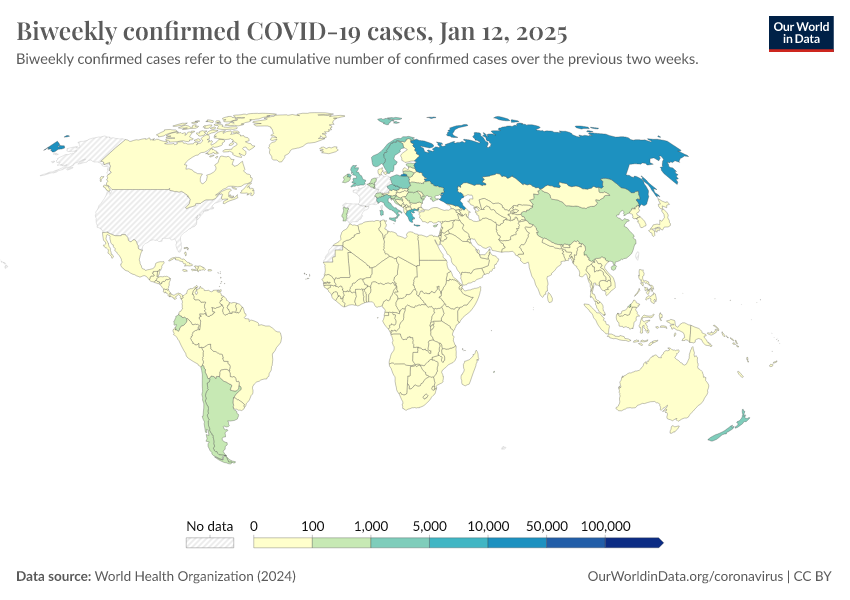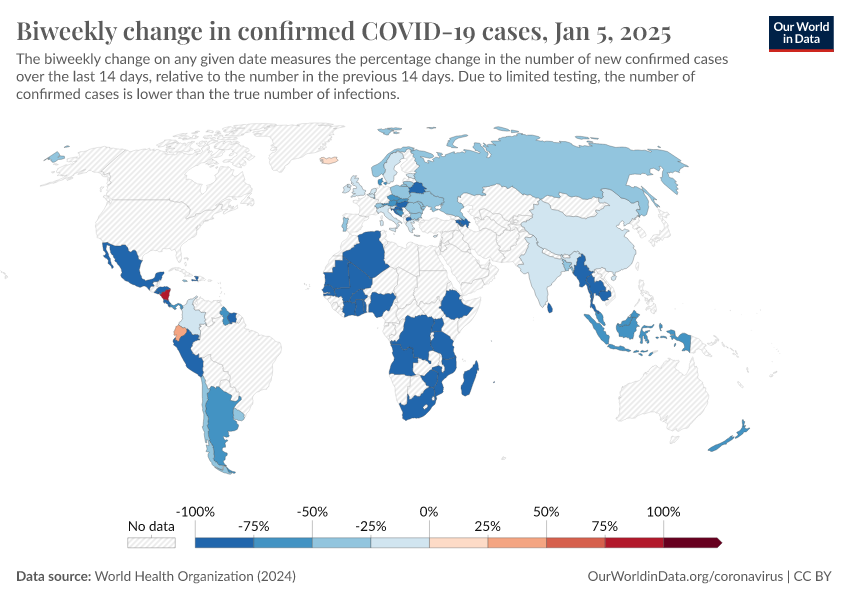Coronavirus (COVID-19) Cases
Explore the global data on confirmed COVID-19 cases
Confirmed cases
This page presents data on confirmed cases, meaning the number of people who have been tested and confirmed to be infected by the SARS-CoV-2 virus.
International organizations, whose data we present, aim to report confirmed cases because they provide a high degree of certainty that the person has COVID-19.
But not everyone is tested, which means the figures are lower than the people infected by COVID-19.
In many countries, testing for COVID-19 is very limited, so the number of confirmed cases can be much lower than the number of actual infections.
On our related page, you can learn more about testing for COVID-19:
Coronavirus (COVID-19) Testing
In addition, there is a delay between testing, confirming, and reporting a case to international organizations. This means the numbers do not necessarily reflect the number of cases on the specific date.
Related articles:
- How epidemiological models of COVID-19 help us estimate the true number of infections
- Our World in Data will rely on data from the WHO to track confirmed COVID-19 cases and deaths
- How to read the famous coronavirus trajectory chart — video explainer
What is the daily number of confirmed cases?
This chart shows the daily number of confirmed COVID-19 cases, as a 7-day rolling average.
What is important to note about these case figures?
- The actual number of infections is likely to be much higher than the number of confirmed cases – this is due to limited testing
- The reported case figures on a given date do not necessarily show the number of new cases on that day: this is due to delays in reporting
We provide more detail on these points in the section 'Cases of COVID-19: background'.
Related chart:

Daily confirmed cases by region
Which world regions have the most confirmed cases in total?
Daily confirmed cases per million people
There are often large differences in the population size between countries. Therefore, to compare cases between countries, it is more insightful to look at the number of confirmed cases as a rate per million people.
But some countries conduct very little testing, so their actual number of infections can be much higher than the number of confirmed cases shown here.
What is the cumulative number of confirmed cases?
This chart shows the cumulative number of confirmed cases in the country over time.
Each country’s trajectory on the chart begins on the day when they had reached 100 confirmed cases. This allows you to compare how quickly the number of confirmed cases grew in different countries.
Keep in mind that in countries that do very little testing, so their actual number of infections can be much higher than the number of confirmed cases shown here.
Related charts:

Cumulative confirmed cases by region
Which world regions have the most confirmed cases in total?

Tests conducted vs. confirmed cases [scatterplot]
How do the number of tests compare to the number of confirmed COVID-19 cases? See them plotted against each other.
Cumulative confirmed cases per million people
This map shows the cumulative number of confirmed cases per million people in each country.
Weekly and biweekly cases: where are confirmed cases increasing or falling?
Why is it useful to look at weekly or biweekly changes in confirmed cases?
For all global data sources on the pandemic, daily data does not necessarily refer to the number of new confirmed cases on that day – but to the cases reported on that day.
Since reporting can fluctuate very significantly from day to day – regardless of an underlying change in new cases – it is more helpful to look at changes from week to week.
This provides a slightly clearer picture of where the outbreak is growing, slowing down, or in fact shrinking.
The first set of maps shows the weekly show figures on weekly and biweekly confirmed cases.
The weekly number is a sum of the number of confirmed cases over a 7-day period, while the biweekly number shows cases over a 14-day period.
The second set of maps shows the growth rate over this period.




Coronavirus sequences by variant
About this data
Our data on SARS-CoV-2 sequencing and variants is sourced from GISAID, a global science initiative that provides open access to genomic data of SARS-CoV-2. We recognize the work of the authors and laboratories responsible for producing this data and sharing it via the GISAID initiative.
Khare, S., et al (2021) GISAID’s Role in Pandemic Response. China CDC Weekly, 3(49): 1049-1051. doi: 10.46234/ccdcw2021.255 PMCID: 8668406
Elbe, S. and Buckland-Merrett, G. (2017) Data, disease and diplomacy: GISAID’s innovative contribution to global health. Global Challenges, 1:33-46. doi:10.1002/gch2.1018 PMCID: 31565258
Shu, Y. and McCauley, J. (2017) GISAID: from vision to reality. EuroSurveillance, 22(13) doi:10.2807/1560-7917.ES.2017.22.13.30494 PMCID: PMC5388101
We download aggregate-level data via CoVariants.org.
All countries report data on the results from sequenced samples every 14 days, although some of them may share partial data in advance.
We obtain the share of cases of each variant by dividing the number of sequences labeled for that variant by the total number of sequences. Since only a fraction of all cases have their genome sequenced, this share may not reflect the complete breakdown of cases.
In addition, recently discovered or actively monitored variants may be overrepresented, as suspected cases of these variants may be sequenced preferentially or faster than other cases.



Confirmed deaths and cases: our data source
Our World in Data relies on data from the World Health Organization
In this document, the many linked charts, our COVID-19 Data Explorer, and the Complete COVID-19 dataset, we report and visualize the data on confirmed cases and deaths from the World Health Organization (WHO).
We make the data in our charts and tables downloadable as complete and structured CSV, XLSX, and JSON files on GitHub.
From 31 December 2019, the WHO has published updates on confirmed cases and deaths on its dashboard for all countries. From 31 December 2019 to 21 March 2020, this data was sourced through official communications under the International Health Regulations (IHR, 2005), complemented by publications on official ministries of health websites and social media accounts. Since 22 March 2020, the data has been compiled through WHO region-specific dashboards or direct reporting to WHO.
The WHO updates its data once per week.
Cases of COVID-19: background
How is a COVID-19 case defined?
In epidemiology, individuals who meet the case definition of a disease are often categorized on three different levels.
These definitions are often specific to the particular disease but generally have some clear and overlapping criteria.
As with other diseases, cases of COVID-19 are broadly defined under a three-level system: suspected, probable, and confirmed cases.
- Suspected case: A suspected case is someone who shows clinical signs and symptoms of having COVID-19, but has not been laboratory-tested.
- Probable case: A suspected case with an epidemiological link to a confirmed case. This means someone who is showing symptoms of COVID-19 and has either been in close contact with a positive case, or is in an area particularly affected by COVID.1
- Confirmed case: A confirmed case is “a person with laboratory confirmation of COVID-19 infection”, as the World Health Organization (WHO) explains.2
How are cases reported?
We have three levels of case definition: suspected, probable, and confirmed cases. What is measured and reported by governments and international organizations?
International organizations – namely the WHO and European CDC – report case figures submitted by national governments.
They aim to report confirmed cases wherever possible because laboratory confirmation gives them a higher degree of certainty.
However, international bodies can only provide figures as submitted by national governments and reporting institutions.
Countries may have slightly different criteria for how cases are defined and reported.3
Some countries also changed their reporting methodologies during the outbreak to include probable cases as well. In contrast, suspected case figures are usually not reported.
Reported new cases on a particular day do not necessarily represent new cases on that day
The number of confirmed cases reported by any institution on a given day does not represent the actual number of new cases on that date.
This is because there is a long reporting chain between when a new case is confirmed and when it is included in national or international statistics.
The steps in this chain may vary between countries, but usually include the following steps:
- The doctor or laboratory diagnoses a COVID-19 case based on testing or a combination of symptoms and epidemiological probability (such as a close family member testing positive).
- The doctor or laboratory submits a report to the health department of the city or local district.
- The health department receives the report and records each individual case in the reporting system, including patient information.
- The ministry or another governmental organization brings this data together and publishes the latest figures.
- International data bodies such as the WHO or the ECDC then collate statistics from hundreds of such national accounts.
This reporting chain can take several days, so the figures reported on any given date do not necessarily reflect the number of new cases on that specific date.
The number of actual cases is higher than the number of confirmed cases
To understand the scale of the COVID-19 outbreak and how it is progressing, we would want to know how many people are infected by COVID-19. We would want to know the actual number of infections.
However, the actual number of COVID-19 infections is not known. When media outlets claim to report the ‘number of cases’ they are not being precise and omit to say that it is the number of confirmed cases they speak about.
The actual number of infections is not known, not by us at Our World in Data, nor by any other research, governmental, or reporting institution.
The number of confirmed cases is lower than the number of actual infections because not everyone is tested. Not all who have been infected have a “laboratory confirmation”. Testing is what makes the difference between the number of confirmed cases and actual infections.
All countries have been struggling to test a large number of cases, which means that not every person who should have been tested has been tested.
Since understanding the testing for COVID-19 is crucial for interpreting the reported numbers of confirmed cases, we have examined the testing for COVID-19 in more detail.
You can find our work on testing here. In a separate post, we discuss how models of COVID-19 help us estimate the actual number of cases.
Acknowledgments
We are grateful to everyone whose editorial review and expert feedback on this work helped us to continuously improve our work on the pandemic.
We would like to acknowledge and thank a number of people in the development of this work: Carl Bergstrom, Bernadeta Dadonaite, Natalie Dean, Joel Hellewell, Jason Hendry, Adam Kucharski, Moritz Kraemer, and Eric Topol for their very helpful and detailed comments and suggestions on earlier versions of this work. We thank Tom Chivers for his editorial review and feedback.
We would also like to thank the hundreds of readers who have given us feedback on this work. Your feedback allows us to continuously clarify and improve it. We very much appreciate you taking the time to write. We cannot respond to every message we receive, but we do read all feedback and aim to take the many helpful ideas into account.
Our work belongs to everyone
Download the complete Our World in Data COVID-19 dataset
- All our code is open-source
- All our research and visualizations are free for everyone to use for all purposes
Endnotes
The European CDC discusses the criteria for what constitutes a probable case, and a ‘close contact’ here.
See any Situation Report by the WHO – for example Situation Report 50. The WHO also speaks of ‘suspected cases’ and ‘probable cases’, but the WHO Situation Reports do not provide figures on ‘probable cases’, and only report ‘suspected cases’ for Chinese provinces (‘suspected cases’ by country is not available). In Situation Report 50, they define these as follows: Suspect case A. A patient with acute respiratory illness (fever and at least one sign/symptom of respiratory disease (e.g., cough, shortness of breath), AND with no other etiology that fully explains the clinical presentation AND a history of travel to or residence in a country/area or territory reporting local transmission (See situation report) of COVID-19 disease during the 14 days prior to symptom onset. OR B. A patient with any acute respiratory illness AND having been in contact with a confirmed or probable COVID-19 case (see definition of contact) in the last 14 days prior to onset of symptoms; OR C. A patient with severe acute respiratory infection (fever and at least one sign/symptom of respiratory disease (e.g., cough, shortness breath) AND requiring hospitalization AND with no other etiology that fully explains the clinical presentation. Probable case A suspect case for whom testing for COVID-19 is inconclusive. Typically, for a case to be confirmed, a person must have a positive result from laboratory tests. This is true regardless of whether they have shown symptoms of COVID-19 or not. This means that the number of confirmed cases is lower than the number of probable cases, which is in turn lower than the number of suspected cases. The gap between these figures is partially explained by limited testing for the disease.
The US, for example, uses the following definitions: “A confirmed case or death is defined by meeting confirmatory laboratory evidence for COVID-19. A probable case or death is defined by i) meeting clinical criteria AND epidemiologic evidence with no confirmatory laboratory testing performed for COVID-19; or ii) meeting presumptive laboratory evidence AND either clinical criteria OR epidemiologic evidence; or iii) meeting vital records criteria with no confirmatory laboratory testing performed for COVID19.”
Cite this work
Our articles and data visualizations rely on work from many different people and organizations. When citing this article, please also cite the underlying data sources. This article can be cited as:
Edouard Mathieu, Hannah Ritchie, Lucas Rodés-Guirao, Cameron Appel, Daniel Gavrilov, Charlie Giattino, Joe Hasell, Bobbie Macdonald, Saloni Dattani, Diana Beltekian, Esteban Ortiz-Ospina, and Max Roser (2020) - “Coronavirus (COVID-19) Cases” Published online at OurWorldinData.org. Retrieved from: 'https://archive.ourworldindata.org/20251207-063327/covid-cases.html' [Online Resource] (archived on December 7, 2025).BibTeX citation
@article{owid-covid-cases,
author = {Edouard Mathieu and Hannah Ritchie and Lucas Rodés-Guirao and Cameron Appel and Daniel Gavrilov and Charlie Giattino and Joe Hasell and Bobbie Macdonald and Saloni Dattani and Diana Beltekian and Esteban Ortiz-Ospina and Max Roser},
title = {Coronavirus (COVID-19) Cases},
journal = {Our World in Data},
year = {2020},
note = {https://archive.ourworldindata.org/20251207-063327/covid-cases.html}
}Reuse this work freely
All visualizations, data, and code produced by Our World in Data are completely open access under the Creative Commons BY license. You have the permission to use, distribute, and reproduce these in any medium, provided the source and authors are credited.
The data produced by third parties and made available by Our World in Data is subject to the license terms from the original third-party authors. We will always indicate the original source of the data in our documentation, so you should always check the license of any such third-party data before use and redistribution.
All of our charts can be embedded in any site.